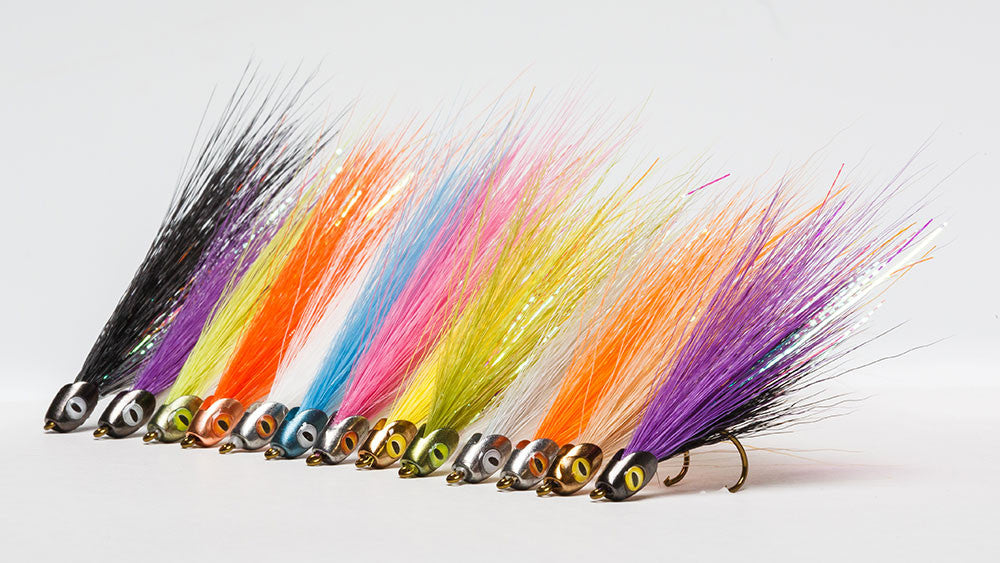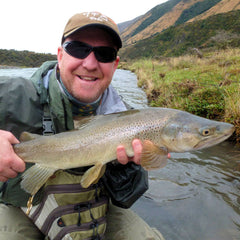Inside Look: Designing Fish-Skull Faux Bucktail.

Taking synthetic fly tying fibers to the next level.
We're excited to introduce our newest fly tying material, Fish-Skull® Faux Bucktail™, which is the first synthetic fiber tapered to a point like real animal fur for use in fly tying and lure making.
Bringing up the word “bucktail” in the fishing and fly tying community immediately evokes a wide range of passions, emotions and strong opinions!
Natural bucktail was one of the first (and is still one of the best) materials available to make flies, lures, and jigs.
However, as fly tyers we share in the general frustration of the difficulty of finding quality bucktail with long fibers on a consistent basis.
We wanted to create a synthetic fiber with similar features to bucktail and properties that would allow it to be used as a more multi-purpose tying material with improvements over existing non-tapered synthetic fibers.
To explain, normal synthetic fibers have exactly the same thickness from one end to the other. This creates a consistent stiffness along the full length of the fiber, which does not allow the energy generated from the front of the fly or lure (as it moves through the water) to accelerate along the full length of the fiber to the back in the same way that a tapered fiber does.
To illustrate this concept, think of how much easier it is to crack a whip than it is to crack a length of rope! In summary, a tapered fiber will give your fly or lure better action.
The word “faux” is a French word that means made in imitation; artificial. Not genuine; fake. So by definition, “Faux Bucktail” is an artificial tapered fiber that imitates (similar appearance, look-and-feel, fishing performance) natural bucktail.
Faux Bucktail fibers can be used in a wide range of fly and lure types.
Popper
Clouser Minnow
Tied by Daniel Moss.
Adam Harman of Blue Ridge Custom Flies uses Faux Bucktail on his nymphs.
- Trout flies: Beautiful tapered wrapped “quill” bodies, nymph wing cases, Mayfly tails and legs.
- Streamers: From tying typical Clouser Minnows or Deceivers right up to large, “bite-proof” Pike, Musky or Golden Dorado flies.
- Poppers: Tie simple and durable tails on foam poppers
- Bucktail Jigs: Tougher, longer lasting fresh and saltwater bucktail jigs.
- Musky Bucktail Lures or dressed trebles.
One of the real strengths of Faux Bucktail is that it blends and combines very well with both natural bucktail and other synthetic/non-synthetic fly tying materials.
For example, it helps fly tyers to get more use out of their natural bucktails by providing an easy source of longer fibers that can be combined with the shorter fibers often not fully utilized on a natural bucktail.
Tied by Tony Sandrone of Nightmare Musky Flies.
Set your expectations for this new material correctly by understanding the similarities and differences of the material compared to natural bucktail, and I am confident you will find Faux Bucktail to be a versatile multi-purpose material with different applications that you easily add to your arsenal of fly tying or lure making materials.
If you take one thing from this article, remember this: Faux Bucktail looks like natural bucktail in the water, but requires some different tying techniques than natural bucktail.
Similarities to natural bucktail.
Fish-Skull Faux Bucktail fibers have the same basic diameter, gentle crinkle, and taper as natural bucktail.
In appearance, it looks almost identical and has the same distinctive bucktail fly or lure action in the water.
The differences from natural bucktail are where it really gets interesting.
Differences from natural bucktail.
Consistent length.
Every Faux Bucktail fiber is premium 6” (152 mm) length, giving you more than twice the amount of usable fibers per tail and eliminating the headache of sorting and searching for ideal strands.
Each Faux Bucktail bundle of fibers is glued together at the base making it easy and convenient to work with. Simply peel off the full length of your desired amount of fibers, trim to length, and tie them in.
All the fibers are already “pre-stacked," but like natural bucktail, a clump of fibers can be easily pulled and teased out to create a nice tapered tail, wing or body on your fly or lure.
Permanent color and sheen.
Faux Bucktail is available in 12 vibrant, consistent colors that will not bleed onto your hands while tying or fade from constant fishing. The fibers also have a semi-translucent sheen to them in the water, which looks great!
Faux Bucktail fibers are solid, not hollow like natural bucktail.
Faux Bucktail has less buoyancy than natural bucktail and will sink down in the water column faster. This is usually an advantage.
Designed to hold up to the toothy rigors of big-game fishing (“bite-proof”), Faux Bucktail fibers bond with super glue or other adhesives better than natural fibers, which secures eyes, thread wraps and other materials firmly in place and increases the lifespan of your flies or lures.
Because Faux Bucktail fibers are solid, traditional tying techniques used to "flare" natural bucktail (which rely on the fibers being hollow to work) will not be effective. This means you will need to tie with slightly different techniques to achieve the same effect when "hollow" or "reverse" tying.
Faux Bucktail fibers are more slippery than natural bucktail.
Like most synthetic fibers, Faux Bucktail is quite slippery and your thread may tend to slip (especially when wrapping a thread head). This can be frustrating, but some small adjustments to your tying technique can make this easier.
i. Use a strong thread (like Veravas 210 denier) and simply spin your bobbin multiple times while suspended from the fly in order to twist your tying thread into a tight “rope”. This gives the thread a nice rough texture which helps bite down and grip into the material.
ii. Put a drop of super glue (like Loctite Gel) on the base before making your first thread wrap. This immediately helps the thread to grab hold and stop slipping forward.
iii. Tie a small “thread ball” about an 1/8” in front of the tie-in point. This creates a small “valley” between the tie-in point and the thread ball to give the Faux Bucktail a place to fold down/sink into when you make your first wraps and overcomes the tendency of the thread to slip forwards.
The fibers can be hard on your scissors.
Faux Bucktail cuts easily, but like most other synthetic materials can be hard on your nice scissors! Use one of the serrated heavy duty scissors designed for synthetics that are now available (or an old pair you don’t mind abusing).
Sheds water.
No more waterlogged flies or lures. Faux Bucktail fibers keep your flies light and easy to cast all day.
No smell.

Unlike natural bucktail, Faux Bucktail will make the fish you are targeting (and your spouse) much, much happier!
Get tying!
Dive in, start creating, and catch some fish!
About Martin Bawden:
 Martin is the founder of Flymen Fishing Company and the head product designer. When not on the water “field testing,” he can be found tying at fly fishing events. Articles on his innovative fly tying products and fly patterns have appeared in various fly fishing publications.
Martin is the founder of Flymen Fishing Company and the head product designer. When not on the water “field testing,” he can be found tying at fly fishing events. Articles on his innovative fly tying products and fly patterns have appeared in various fly fishing publications.












Wow!!! Love this blog!! I think it’ll take a couple of cups of coffee to digest this information. There’s so much to appreciate and learn from here. I love the Faux Bucktail material and this blog will help me appreciate it even more. Thanks Martin!!
Thanks for pointing out the differences between natural and Faux bucktail. I haven’t had a chance to get my hands on any as of yet and was hesitant to make the jump until I learned more about it. There is nothing in tying that is more frustrating than getting a material that doesn’t meet your needs or expectations.
Your honest review of it’s qualities and potential changes tiers will need to make in approaching the material has convinced me to give it a try. Thank you for the tips on its usage as well as pointing out how it behaves differently in some respects to natural bucktail. I’ll be ordering a bunch soon!
Leave a comment